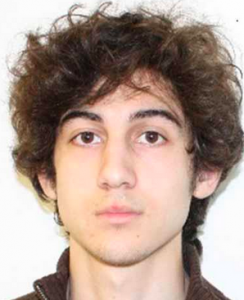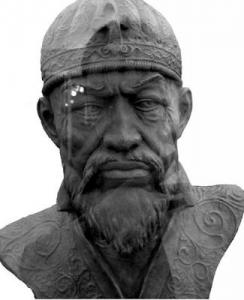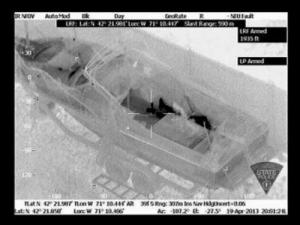On science blogs: After the Boston bombs
THE BROTHERS TSARNAEV: WHY? Joel Breuklander has had it with people expressing sympathy for Dzhokhar Tsarnaev. In the Atlantic, Breuklander recaps some over-the-top presentations of Dzhokhar-as-victim, identifies himself as a mushy-headed liberal, and observes
this all sounds like a conservative parody of mushy-headed liberal thinking. It's reminiscent of the kind of person who sees George W. Bush's dog paintings and forgets his involvement in two wars put on credit and a global economic collapse.
Some of the ideas that so exasperate Breuklander might qualify as scientific hypotheses about what lay behind the Boston Marathon bombings and their aftermath. Most are at least speculations with some scientific backing. For example, Jane Stevens, who edits the web site ACES Too High — ACES being the acronym for adverse childhood experiences — thinks someone ought to be looking at the childhoods of the brothers Tsarnaev "through a trauma-informed lens" when seeking explanations for what might have led them to become bombers. That's because the CDC’s Adverse Childhood Experiences Study, which Stevens calls "the largest public health study you never heard of," links childhood trauma to the commission of later violence. In the case of the Brothers Tsarnaev, Stevens suggests, the traumas could have included war and an early life as refugees, unstable family life, uncontrolled anger, failing in school, and, in Dzhokhar's case, heavy pot smoking and perhaps dealing.
At Healthland, Jeffrey Kluger speculates that the elder brother, Tamerlan Tsarnaev, might have been just another victim in a well-established arena for traumatic brain injury: the boxing ring, where he took part in the New England Golden Gloves competition. Kluger thinks it likely Tsarnaev did suffer brain damage, but doubts that any such injury can be blamed for the Boston murders.
Meredith Melnick wonders why terrorists are so often young men. At HuffPo, she interviews psychologists to find out, with little success. The psychologists acknowledge that these demographic facts are correct, and of course also true of mass murderers and crime in general, not to mention auto accidents and, for that matter, accidents of all kinds. But they don't know why either. Something to do with brain development maybe. Mumble mumble. Testosterone. Mumble. Lack of self-control. Mumble mumble. Hey, listen, adolescence is a tough time, y'know?
And then there are those who blame Islam for creating what Vice-President Joe Biden called "two twisted, perverted, cowardly knock-off jihadis." This argument is to be found on some science blogs — or maybe they should be called nominal science blogs because they are consistently political — that are battling with each other about the Boston events. At Why Evolution is True, uber-atheist Jerry Coyne slammed Islam in particular and religion in general, quite certain that blame for the bombings lies with religious indoctrination. At Collide-a-Scape, Keith Kloor called that an indictment of an entire religion based on the murderous activities of a few adherents. So Coyne then called Kloor "a devout accommodationist." And so Kloor said — well, read the posts yourself if you care to view what is clearly a long-standing, not to say permanent, feud.
At the Panda's Thumb, Nick Matzke savages Coyne as well, charging that his anti-religious critiques employ the same (unacceptable) tactics that Christian fundamentalists use against atheists. Matzke provides lengthy quotes from NPR and the Wall Street Journal as evidence that the brothers Tsarnaev, Tamerlan in particular, thoroughly disapproved of patriotic American Muslims.
Getting back to basics, could be that it's a mistake to name a boy after a 14th Century warrior who conquered much of Asia, sought to restore the empire of Ghengis Khan, and employed Islam for political ends. So far as I know there's no scientific basis whatever for this declaration, but what I say is, let's err on the side of caution. Why give a kid ideas and tempt fate?
THE BOSTON MARATHON JOURNAL OF MEDICINE. In the aftermath we have heard from docs about their post-Marathon experiences. Knight Science Journalism Tracker Paul Raeburn describes Sushrut Jangi's NEJM piece about what it was like in the medical tent when the bombs went off. Shirie Leng practices at Beth Israel, where Dzhokhar Tsarnaev was both patient and prisoner. At the Health Care Blog, she quotes Aristotle, considers the rules protecting patient privacy, and notes how, in this case, they clash mightily with human curiosity.
There has been a flurry of emails and red-letter warnings cautioning people here not to talk about Mr. Tsarnaev or look him up on the EMR (Electronic Medical Record) system. Despite this there have been leaks of information and photos from various sources.
Leana Wen is an ER doc at Mass General. At Shots she describes what it was like to be on duty there when the bombs blew. She was frantically busy "with shattered bones, bloody stumps and bodies riddled with nails and pellets." But she was also frantic about not hearing from her husband, a Marathon spectator, who had mislaid his cell phone and couldn't let her know he was OK.
I do know that as much anger and sorrow as many may harbor, we need thoughtful reflection to prevent the wrong ideas from taking hold. The suspects are immigrants, but so are many of the first responders and emergency care providers — like me, an immigrant who came here on political asylum from China.
Kyle Hill's guest blog at SciAm explains how it was possible to use an infrared camera mounted on a police helicopter to capture an image of Dzhokhar Tsarneav hiding in the boat.
When police “looked through” the tarp of the boat Tsarneav was hiding in, they saw him because his body’s output of long wavelengths were making it through the boat tarp material, not some Superman-like X-ray vision.
It's a bit counterintuitive to learn that Tsarneav could have hidden successfully from the IR camera behind ordinary window glass because glass is designed to block IR radiation.
INFORMATION MAY WANT TO BE FREE, BUT DOES IT ALSO WANT TO BE ACCURATE? At the Nieman Journalism Lab, Mark Coddington has just published a comprehensive summary, with links, of stumbles and successes in coverage of the Boston Marathon events. He includes social media, especially the Reddit fiasco, as well as MSM.
Innovation to the rescue. Maybe. At Technology Review, David Talbot surveys some new approaches to verifying news on both social and conventional media. They include Storyful, Swift River and, coming soon, Verily.
Meanwhile, already here is Churnalism, a new, free, open-source tool for detecting plagiarism that Rebecca Rosen described at the Atlantic. In this case plagiarism includes not just someone else absconding with and taking credit for a piece you wrote, or the lifting of material from Wikipedia and other reference sources. It also includes the phenomenon often called churnalism, now rampant in the media — the presentation of press releases or other sponsored material, in whole or in part, as if they were independent and original news articles.
Churnalism has built a big database of press releases from many sources, including Eurekalert. It also plumbs many large media sources, and you can add additional repositories. A suspect piece can be run through Churnalism at its own site here, and there are also Churnalism plugins for Chrome, Firefox, and Internet Explorer. I have had no success with a brief test of the Firefox plugin, which is in beta. But that could mean the material I've selected for testing is blameless, and wouldn't that be nice.
Churnalism is a tool we writers badly need, and if it works as advertised, it's a treasure.






